Understanding Vintage Tudor Submariner watches
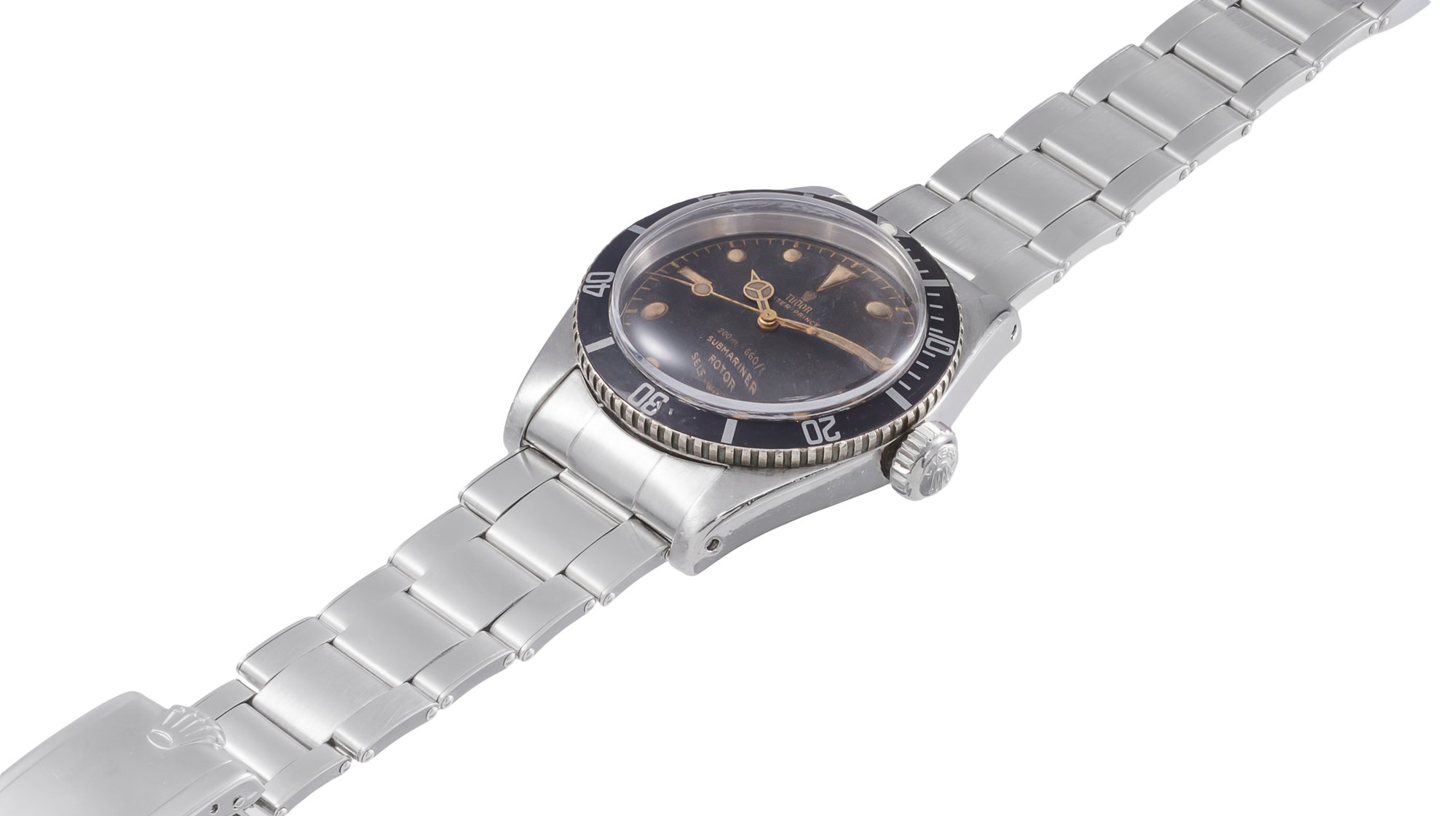
Published: Jul 17, 2021
If you’re looking to learn more about the Tudor watch brand and its most iconic watch collection to date - the Tudor Submariner - you’ve found the right place. In this article we will look at some of Tudor’s most popular and collectable vintage Submariner watches, along with the inspiration behind the famous design, the ethos of Tudor as a brand, and how the prices of vintage Tudor Submariner watches vary from one model to another.
Tudor is a luxury watch brand highly revered across the globe for creating exceptionally reliable wristwatches at an affordable price. Some of the most recognisable wristwatches developed by the brand include the Black Bay, the Heritage, Pelagos and North Flag, but most of all - the Tudor Submariner. The famous Swiss watchmaker, based in Geneva, has created some remarkably distinct and highly coveted wristwatches since it was founded back in 1926. This is true for both current and vintage Tudor watches. The core focus of the manufacturer has remained steadfast throughout its 95-year heritage; to develop high-quality wristwatches powered by precise movements using expert craftsmanship. If you’re looking to buy your first vintage Tudor watch, you can part with your money safe in the knowledge that Tudor is a brand that guarantees value for your money. Its approach to watchmaking has remained honest and authentic long after it stepped out of the shadows of its famous sibling brand, Rolex. Over the last few years, the brand has worked hard to establish itself as an independent manufacturer of innovative tool watches. That said, its catalogue also includes simplified dress watches, as well as GMT complications for travel, column-wheel chronographs for sport and, of course, expert dive watches.
The price of a Tudor watch depends considerably on the popularity and rareness of its design. Many Tudor watches make great entry point purchases into the world of luxury watch collecting, whilst others are more expensive because they are in higher demand. Those who consider themselves experienced luxury watch collectors will be aware that some of the most expensive Tudor watches are those belonging to the manufacturer’s highly desirable dive watch range – the Submariner collection, which we’re going to explore in more depth throughout this article. Submariner vintage watches remain at the top of the company’s price range since the demand for pre-owned Tudor watches from this particular collection have risen dramatically over recent years. If you are looking to invest in a Tudor watch as a starting point, there are many reasons to invest. Fitted with high precision movements and with price tags that start from a very affordable 3,700 EUR - many models, new and pre-owned, have the potential to appreciate in value over time. Let’s start with a brief introduction of the Tudor Submariner watch and its key features…
An overview of the vintage Tudor Submariner
Tudor Submariner watches are hugely coveted vintage dive watches with mass appeal. Sought after for their instantly recognisable designs and their ability to appreciate in value, the Submariner watch collection varies from popular models to extremely rare variations – particularly those used by the military, as well as the Big Crown iterations and those outfitted with a manual winding movement. Over the last decade, Tudor Submariner watches have increased in value considerably and are now one of the most talked-about vintage dive watches in the history of Haute Horlogerie. Serious dive watch enthusiasts will already be aware of the Tudor Submariner and its reputation for offering more affordable alternatives to the highly-acclaimed Rolex Submariner. Having said that, its unique design and feature-packed spec, aimed at professional and amateur divers, lends itself to the materials and watchmaking techniques used by Rolex. For this reason, the Tudor Submariner will forever be indebted to the Rolex Submariner. Generally speaking, the Tudor Submariner watch is characterised by its legible dial with square hour markers and matching hands, known by enthusiasts as the “snowflake” hands. The luxury dive tool, developed for the explicit needs of aquatic explorers, marine biologists, sailors, divers and water sports professionals, has also gone through some significant modifications throughout its 30-year legacy.
There has been a total of 20 different versions of the Tudor Submariner watch throughout its production from 1969 to 1999. The indispensable dive tool has undergone changes to its case size, its materials, its bezel design and its dial. It’s also worth mentioning that from a technical point of view, Tudor outfitted the Submariner watch with reliable ETA movements during the second and third phase of its manufacturer, replacing the movements sourced from Fleurier featuring in the brand’s earlier models. To understand how the design of the Tudor Submariner came to be, it is important to first understand what Tudor stands for as a manufacturer and how it birthed the concept of the famous luxury dive watch…
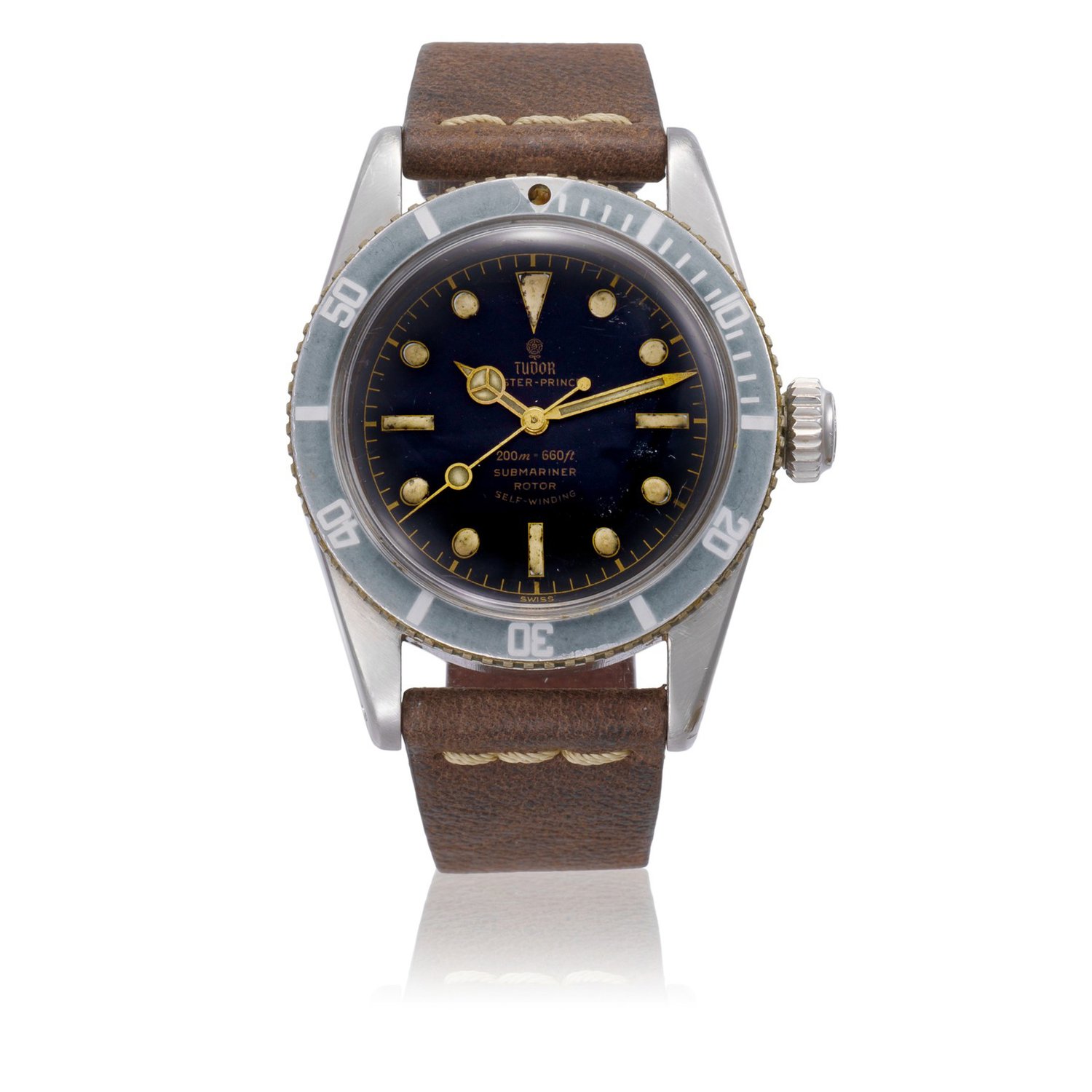
Tudor before the birth of the Submariner
Anyone who considers themselves a true watch aficionado will already be aware that Tudor has a much higher-priced sibling that goes by the name of Rolex. The price tag of a Rolex reflects several things. Firstly, the brand’s provenance and its reputation as the most recognised watch brand in the entire world. Secondly, its in-house manufacture. Having acquired its own materials research and development facility, Rolex has created some of the world’s most robust and durable watches using proprietary alloys and materials. Thanks to state-of-the-art technology and a superior blend of materials, the majority of the Rolex catalogue is geared for extreme exploration, adverse weather conditions and daring missions. These formidable designs are coupled with unfaltering in-house movements, guaranteed to outlive their wearer. For those who have experienced any measure of success in life, saving enough to invest in a Rolex watch is one of life’s greatest achievements. The inspiration behind Tudor’s philosophy is Rolex but on a much more affordable level.
To some, the Tudor brand is known as “the poor man’s Rolex” but to many others, it is a brand highly respected for its accessibility, backed by a rich heritage in Swiss watchmaking. Although synonymous with the same watchmaking values shared by Rolex, the Tudor brand has proved itself more than capable of standing on its own two feet. The company name, Tudor, was registered in 1926 by the house of “Veuve de Philippe Huher” and in 1932, the brand released its first watches. Interestingly, these very first Tudor watches were only made available to the Australian market. These models displayed the original Tudor brand logo - a sign of authenticity and quality that has changed several times since then. The first logo featured an extended horizontal line from the “T” letter, which ran across the top of the other letters. To gain trust and to leverage itself, Tudor sometimes featured the Rolex name upon the dial of its first few watches. Since Rolex was already a renowned name during this time, it made sense for Tudor to take advantage of its connection with the brand.
In the beginning, the manufacturer focused on creating a range of compact dress watches for men and women. The small-sized cases were often barrel or tonneau-shaped and featured bevelled sides. Available to only the most highly-esteemed jewellers in Australia, Tudor soon began creating a reputation for itself synonymous with high-end luxury and exclusivity. Back when Hans Wilsdorf purchased the Tudor name, he envisaged creating a more accessible luxury wristwatch that didn’t compromise on quality or reliability. To bridge this gap, Tudor watches were developed using many Rolex parts and cases but were equipped with off-the-shelf movements to bring the cost of manufacture down and subsequently reduce the retail price of each timepiece. As a result, Tudor watches soon became Rolex’s more affordable alternative. During the mid-1930s the Tudor Rose logo began appearing on the dial. The rose within a shield is a symbol of strength, grace and robustness that is still strongly associated with the brand today. During the 1940s, the shield gradually disappeared, leaving just the rose motif as an applique in relief, imparting a sense of elegance and finesse across the brand’s catalogue. The first official watch collection to be released by Tudor was the Tudor Oyster series – the first waterproof watch developed by the brand and, as such, a fundamental building block to the design of the future Submariner. It borrowed from the waterproof watch of the Rolex Oyster and was originally launched in a compact 34mm-sized case – the order of the day for a watch during this era.
The Oyster Prince was launched not long after the Tudor Oyster, boasting a rugged and confident design that broke away from the elegantly proportioned watches that were dominating the market during this time. The birth of the Oyster Prince in 1952 marked the start at which the brand began heavily focusing its attention on the field of sports watches. A year later, Rolex launched a campaign that would promote Tudor’s new direction towards sporty rugged tool watches. The Oyster Prince watch would be subjected to tests carried out by Rolex experts to determine its strength and capability to withstand challenging conditions. Passing these tests enabled the Tudor Oyster Prince to proudly share Rolex’s famous waterproof Oyster case and its original self-winding Perpetual Rotor.
An overview of the Tudor Submariner’s history
The origins of the Submariner began in 1954 when the French Navy (Marine Nationale) became the watchmaker’s research and development partner for watches in the diving field. The aim to collaborate with the French Navy was to establish the credentials of a faultless dive watch and to improve its design by testing and researching the watch in real conditions. By doing so, Tudor was able to determine how well the watch fixed to the wrist, how comfortable it felt and how effective its water-resistant qualities held up whilst submerged underwater. When developing the first Submariner watch, Tudor intended its aesthetic to mirror that of the Rolex Submariner, but also for its qualities to appeal to those who couldn’t afford or simply refused to invest in one. Appearing on the market in a unique position, the Tudor Submariner was an accessible dive watch, fortified by the knowledge and expertise of a world-renowned manufacturer. This opened up a whole new audience for the Tudor Submariner.
The inspiration behind the diving legend
As mentioned, the Tudor Submariner’s design was based heavily on the Rolex Submariner, released around the same time. The first Submariner No Date watch by Rolex is still one of the world’s most highly-coveted luxury watches in the industry’s entire dive watch history. When Rolex debuted its first Submariner watch in 1953, its remarkably classic yet functional design soon went on to define the features and styling of the ultimate tool watch for divers across the world. Thereby, its design has barely needed to change throughout its entire existence. The only drastic change has been the addition of the date feature ten years after the Submariner’s initial birth, subsequently named the Rolex Submariner Date. The “No Date” version, however, has only ever been offered in a stainless steel case and its dial and bezel have only ever been offered in black. Vintage Rolex Submariner No Date watches initially offered a 100-meter (10 bar or 328 ft) water-resistant capability. For its time, this was impressive and was thus matched in the design of the Tudor Submariner. Not so long after, Rolex increased this to 200 meters (20 bar or 656 ft) as did Tudor. Modern iterations of the Rolex Submariner today (or those made after the year 1979 to be more precise) now come with a promised water-resistance of 300 meters (30 bar or 984 ft). Cleverly, Rolex has always taken a cautious step when it comes to adding modifications to the Rolex Submariner, enabling modern versions to bear resemblance to their original predecessors. The Rolex Submariner featured the famous Mercedes hands shared with the Tudor Submariner but is recognised for its circular dot hour markers as opposed to Tudor’s evolved square-shaped indexes. In 2010, Rolex made some more noticeable changes to its design, creating the ‘maxi’ case and equipping the bezel with a black ceramic inlay as opposed to an aluminium one. The compact and wearer-friendly sizes of the Rolex Submariner have also remained consistent. By recreating a more affordable version of the Submariner in the form of a Tudor watch, Hans Wilsdorf created an accessible dive watch for professionals that tapped into a wider audience of collectors and wearers. The reason why Tudor Submariner watches have remained so highly sought-after on the pre-owned market today is partly down to the exclusivity of each design since its manufacture only lasted up until 1999. True in the sense that all Tudor Submariner watches available on the pre-owned market today are indeed classed as “vintage” Tudor Submariner watchers - each timepiece stands for a landmark in the manufacturer’s history.
The evolution of the Tudor Submariner watch
Throughout its 30-year production, the Tudor Submariner can be broken down into three generations, which we’ll go into detail on shortly. Those from the first generation, developed between the years 1954 and 1968 are considered the most desirable. These Tudor Submariner military versions were utilized on the wrists of the French and American Naval forces. As it was the brand’s first official dive watch, the Submariner pushed Tudor into unfamiliar waters. This new leap was made even more challenging by the fact that loyal Rolex fans felt Tudor was in fact, piggy-backing on the success of the Rolex Submariner and not pushing enough daring boundaries for itself.
First-generation Tudor Submariner watches were equipped with screw-down crowns, large bright hands, rotatable bezels and 100-meter water-resistant capabilities. The crown on the right-hand side of the cases went without any crown guard, however. Their black dials were domed with a distinct gold-coloured script and the Oyster band and crown both featured the Rolex logo engraved upon their surfaces. Within this first generation was the collection’s only manual-winding iteration as well as the Big Crown variation. With an 8mm-wide crown accompanying an optimised case and a plexiglass front, this model was soon followed by a Tudor Submariner with crown protector technology.
The second generation of Tudor Submariner watches is categorised by those developed in 1969 continuing up to the year 1989, with some of the most notable models including the 7016, 7021, 9401, 9411, and 76100. This chapter marked some important milestones for the collection, including its transition from Fleurier movements to ETA movements mentioned earlier. In addition to this, the second generation of Submariner watches represents the phase that Tudor underwent to create a new style of hands. These “snowflake” hands improved legibility underwater and in dark conditions, changing the appearance of the dial thereafter.
The third generation of Submariner watches by Tudor is generally classified as those belonging to the “modern” series, since these were the brand’s most recent designs before production ceased. The third generation of Tudor Submariner watches includes those from the 79000 series, such as the 79090 and 79190 references. Once again, these can be identified by their different dial designs, with triangular indexes replacing the square-shaped markers and an extension of dial colour options.
Popular vintage Tudor Submariner watches
Submariner 7922
The Tudor Oyster Prince Submariner ref: 7922
In 1954, Tudor released its first official dive watch named the Tudor Submariner Oyster Prince. Based on the design of the earlier Rolex Submariner ref: 6538, it utilized the same case, crown and bezel. This was the start of the Tudor Submariner legacy – a point at which the brand was able to pitch itself as a manufacturer of luxury, high-quality sports watches for excellent value. In this model, reflective gilt indexes are applied to a black dial adorned with the Tudor Rose icon. (This was later replaced by the rose inside the shield motif in 1969.) The vintage Tudor Submariner ref: 7922 model marked an important milestone for the manufacturer, paving the way for future Submariner watches to come. Not only was the watch the first foray into the dive watch world for Tudor, but it also underscored the beginning of many dive watch enthusiast’s collections. This particular Submariner watch is incredibly hard to find on the pre-owned market and is powered by a modified Fleurier movement named the calibre 390, which performs at a frequency of 18,000 vibrations per hour. The hour markers on the dial of the 7922 Submariner are radium filled as are the hands. The bidirectional rotating bezel is also identified by a red triangle for the 12 o’clock – a design element that is shared with many early Rolex Submariner watches. The production run of the Tudor ref: 7922 was very short-lived due to the release of the 7923 which followed soon after.
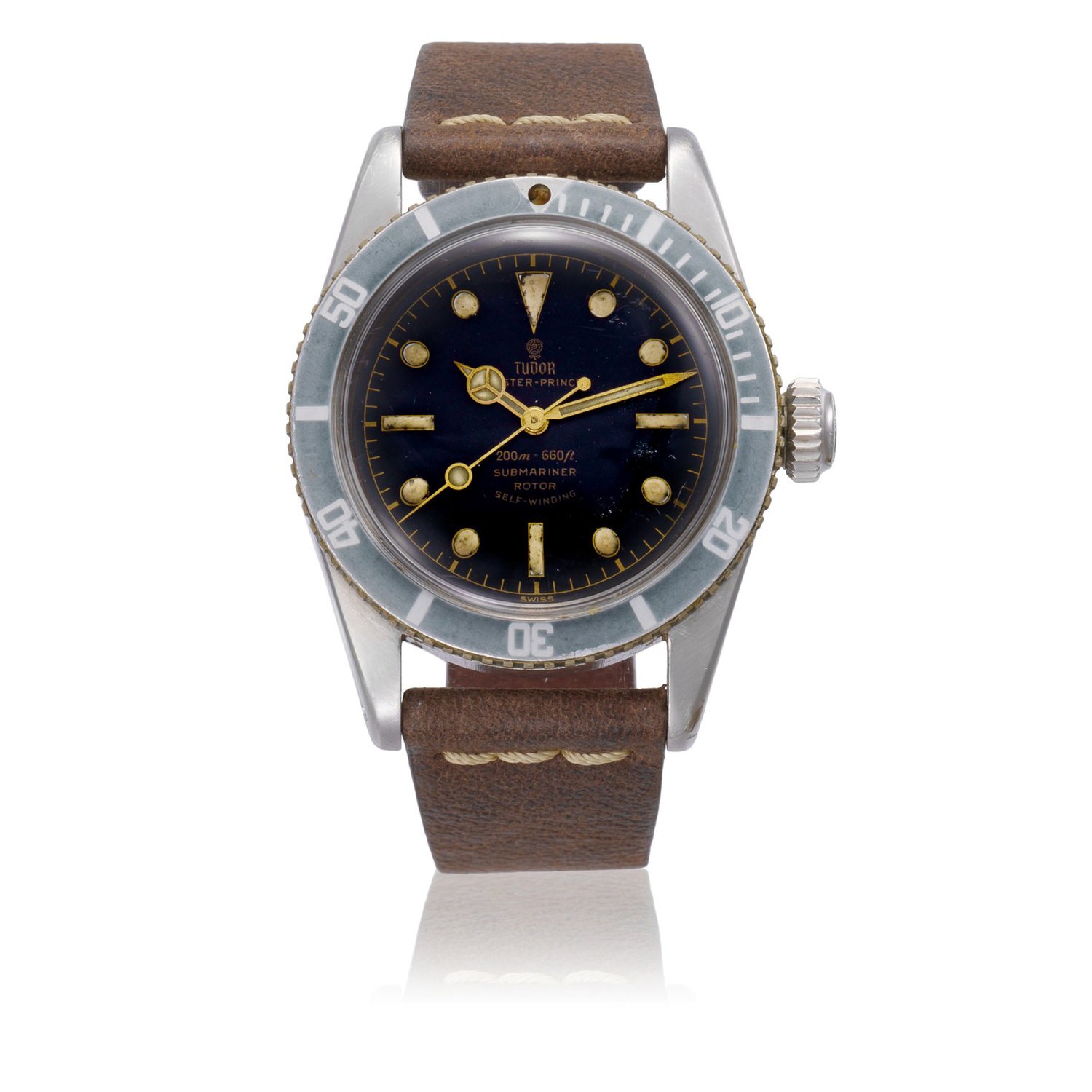
7922 Spec
At a glance:
Name; Tudor Submariner Oyster Prince watch
Reference; 7922
Case: 37mm stainless steel
Crown: 5mm
Glass: Domed acrylic
Release year: 1954
Dial: Black with radium-filled hands and circular indexes
Water resistance: 100 meters
Strap: Three-link stainless steel Oyster
Movement: Fleurier 390 self-winding
The Tudor Submariner Manual Winding ref: 7923
The ref: 7923 from the Tudor Submariner watch series is one of the rarest variations. For many years, collectors questioned whether the model was ever released and only a few enthusiasts have ever seen one. The 7923 is the only Tudor Submariner to be fitted with a manual-winding movement. Similar to its predecessor, the ref: 7922, it features a small crown, black dial and radium-filled plots. One of the most interesting features to note about the ref: 7923 is the lack of the “Prince” lettering – the brand’s reference to an automatic-powered model. Pencil hands occupy the simpler dial of the Submariner ref: 7923, which takes influential cues from the Rolex ref: 6205 watch – a design element that was later borrowed for the design of the brand’s Black Bay ref: 7023/01 which auctioned in 2015.
At a glance:
Name; Tudor Submariner Manual Winding ref: 7923
Reference; 7923
Case: 37mm stainless steel
Crown: 5mm
Glass: Domed acrylic
Release year: 1955
Dial: Black with radium-filled hands and circular indexes without red lettering
Water resistance: 100 meters
Strap: Three-link stainless steel Oyster
Movement: Manual winding Calibre 1182
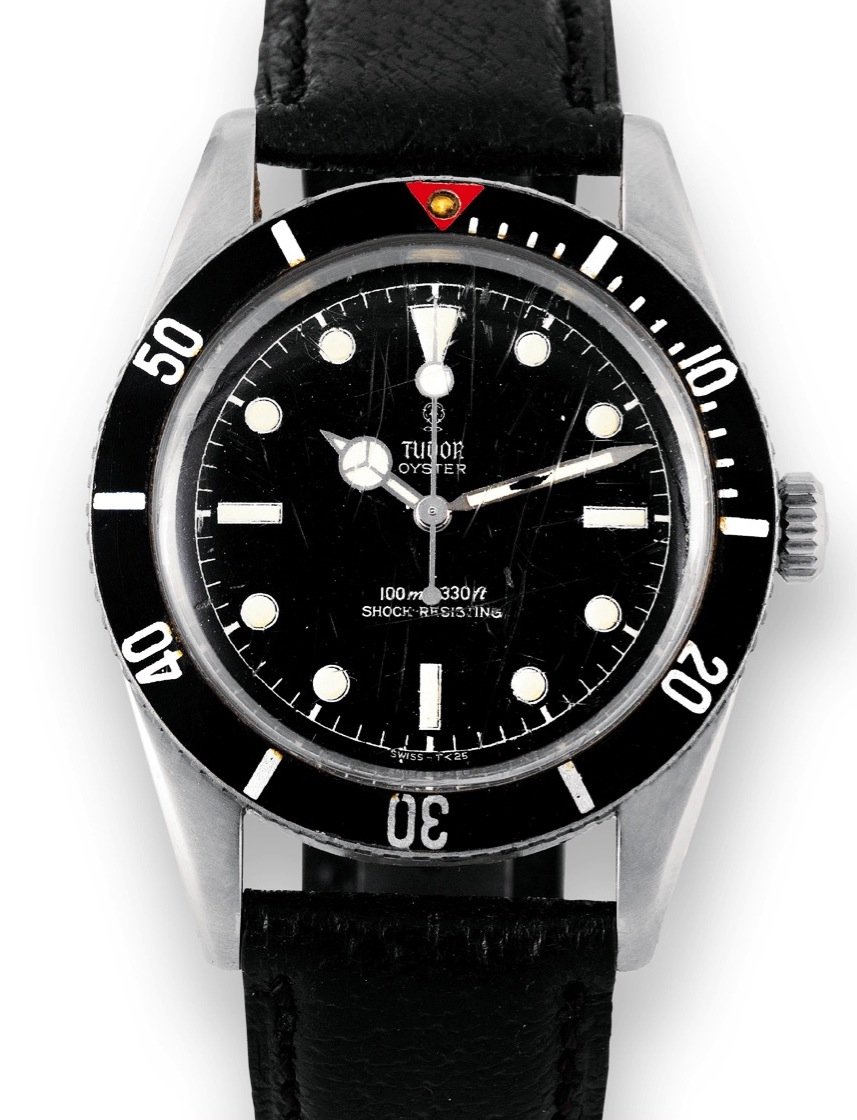
Tudor Submariner Big Crown ref: 7924
Released in 1958, the Tudor Submariner Big Crown ref: 7924 was only a slightly re-designed evolution of the 7922, however, its water-resistant capability was doubled, promising a robust steel case, equipped with 200-meter water resistance (as opposed to the Submariner’s former 100 meters water resistance capability). To compensate for this improved feature, the case of the Tudor Submariner Big Crown featured a thicker-looking profile with an increased crown size from 5mm to 8mm. This enlarged crown feature didn’t come without problems, however. Professional divers were prone to knocking the Submariner’s prominent crown, compromising its water tightness. The vintage Tudor Submariner Big Crown ref: 7924 also featured a thicker glass front made from plexiglass for withstanding great water pressure. The “Brevet” screw-down crown design with the Rolex logo and lack of crown guards made the ref: 7924 very similar to the iconic “James Bond” Rolex Submariner watch. In addition to this, the Tudor Submariner Big Crown watch was finished on a three-link stainless steel Oyster bracelet bearing Rolex’s name and offered a unidirectional diver’s bezel calibrated for 60 units. The hands on the watch’s black dial were the Mercedes style and the 12 o’clock dot on the bezel was luminous for enhanced visibility. The watch was once again powered by the Fleurier Calibre 390 self-winding movement like the earlier 7922 Submariner.
At a glance:
Name; Tudor Submariner Big Crown ref: 7924
Reference; 7924
Case: 37mm stainless steel
Crown: 8mm
Glass: Plexiglass
Release year: 1958
Dial: Black with luminous Mercedes hands and circular hour indexes
Water resistance: 200 meters
Strap: Three-link stainless steel Oyster
Movement: Fleurier 390 self-winding
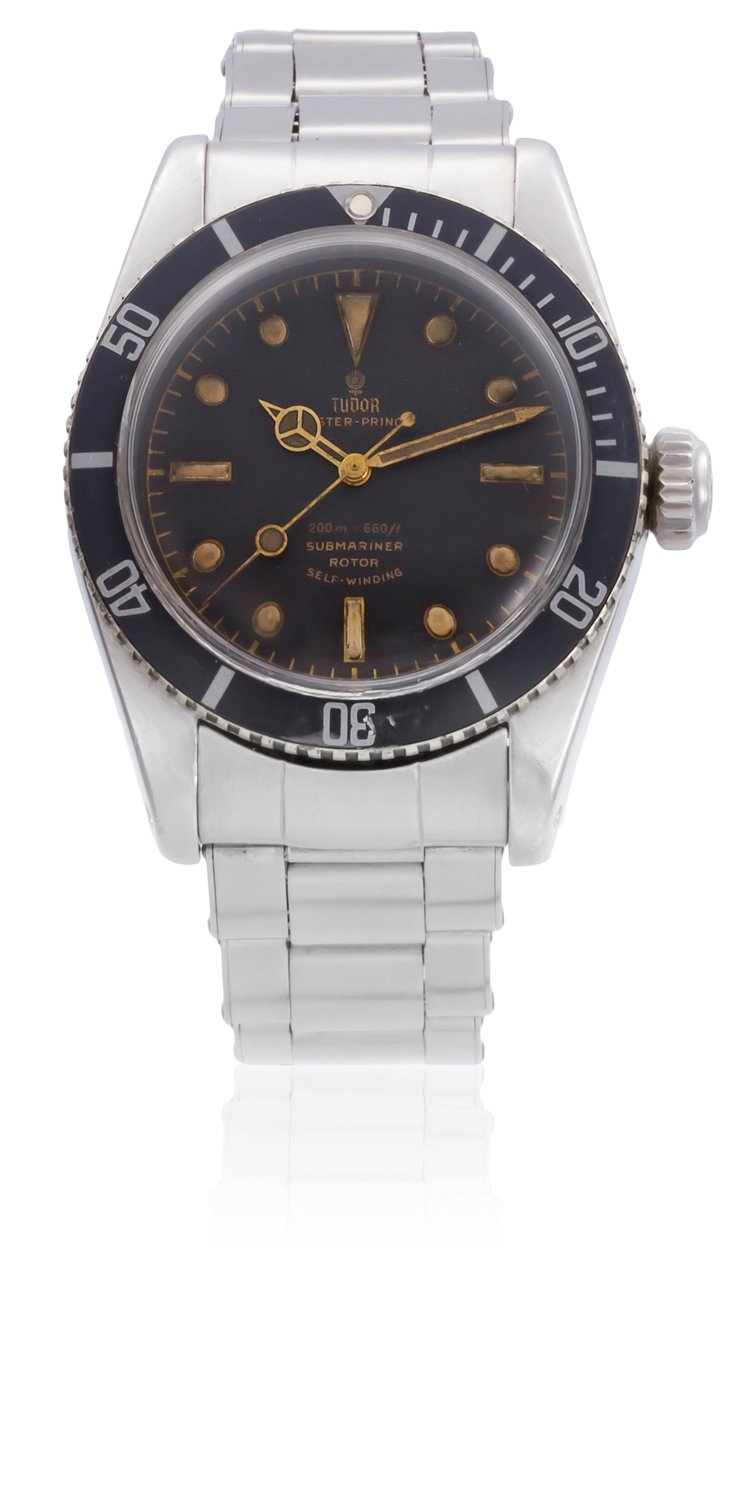
Tudor Submariner Square Crown ref: 7928
The Vintage Tudor Submariner Square Crown ref: 7928 is one of the most classic-looking Tudor Submariner watches of all. Its design is heavily based on the Rolex Submariner ref: 5512 and 5513 and boasted a larger case size, having grown from the previous 37mm case size of the Tudor Submariner 7922 and 7924 to a new 39mm diameter. The rugged aesthetic of the watch’s stainless steel case was once again integrated with 200-meter water resistance and fitted with the Rolex Oyster steel bracelet. The Rolex Oyster bracelet has been a staple in Rolex’s catalogue for over 70 years now and was originally patented in 1947. The origins of the bracelet’s design span back to the 1930s, where they were originally outsourced to the manufacturer, Gay Freres. The style of the links featured in a Rolex has changed over the years. Although always flat, the links have been riveted, folded and solid-filled. The vintage Tudor Submariner Square Crown ref: 7928 was originally developed for the “Marine Nationale”, also known as the French Navy in 1959 making it one of the most desirable. It featured a reduced crown size to a more manageable 6mm. This eradicated the problems experienced with the previous Tudor Submariner ref: 7924 watches, making them less susceptible to “crown shock”. Despite these changes, the overall design of the case, bezel, dial and hands were similar to the ref: 7924, albeit the bezel had slightly deeper teeth. The vintage Tudor ref: 7928 was powered by the Fleurier 390 movement and was produced until around 1968, featuring “Tropical”-style hands from 1964 onwards.
At a glance:
Name; Tudor Submariner Square Crown ref: 7928
Reference; 7928
Case: 39mm stainless steel
Crown: 6mm
Glass: Plexiglass
Release year: 1959
Dial: Black with luminous Mercedes and “Tropical” hands (1964 onwards) and circular hour indexes
Water resistance: 200 meters
Strap: Three-link stainless steel Oyster
Movement: Fleurier 390 self-winding
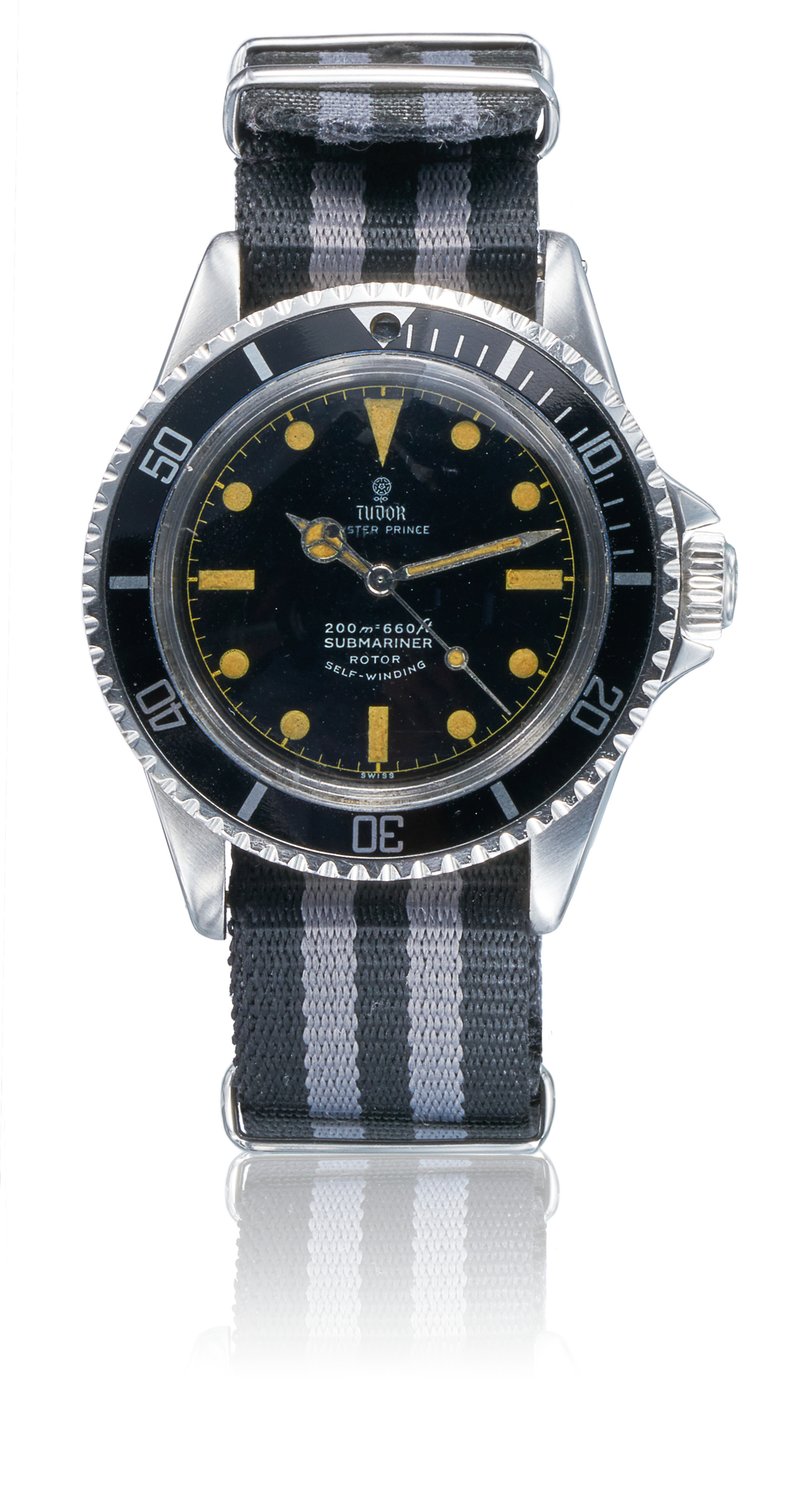
Tudor Submariner Snowflake ref: 7016
The Tudor Snowflake Submariner ref: 7016 model represents the second generation of dive watches developed by the Swiss brand. There were also some notable changes to the production of the Submariner. Firstly, the model was powered by an ETA movement as opposed to the previous Fleurier movements. The ETA 2483 self-winding movement performed at an improved rate of 28,800 vibrations per hour and delivered a 38-hour power reserve. Secondly, to enhance readability underwater and in light-limiting conditions, Tudor redesigned the hands on the dial of the Submariner. These went by the name of “Snowflake” hands and subsequently went on to influence future Tudor Submariner watches to come. Thirdly, the design of the vintage Tudor Submariner ref: 7016 is also where we see the hour markers change from circular to square. Furthermore, the design was available with the option of a blue dial and the size of the case grew once again to measure a confident 40mm diameter on the wrist. Aesthetically, the styling of the case and bezel, however, stayed the same as the ref: 7928.
At a glance:
Name; Tudor Submariner Snowflake ref: 7016
Reference; 7016
Case: 40mm stainless steel
Crown: 6mm
Glass: Plexiglass
Release year: 1959
Dial: Black with luminous Snowflake hands and square hour indexes
Water resistance: 200 meters
Strap: Three-link stainless steel Oyster
Movement: ETA 2483 self-winding
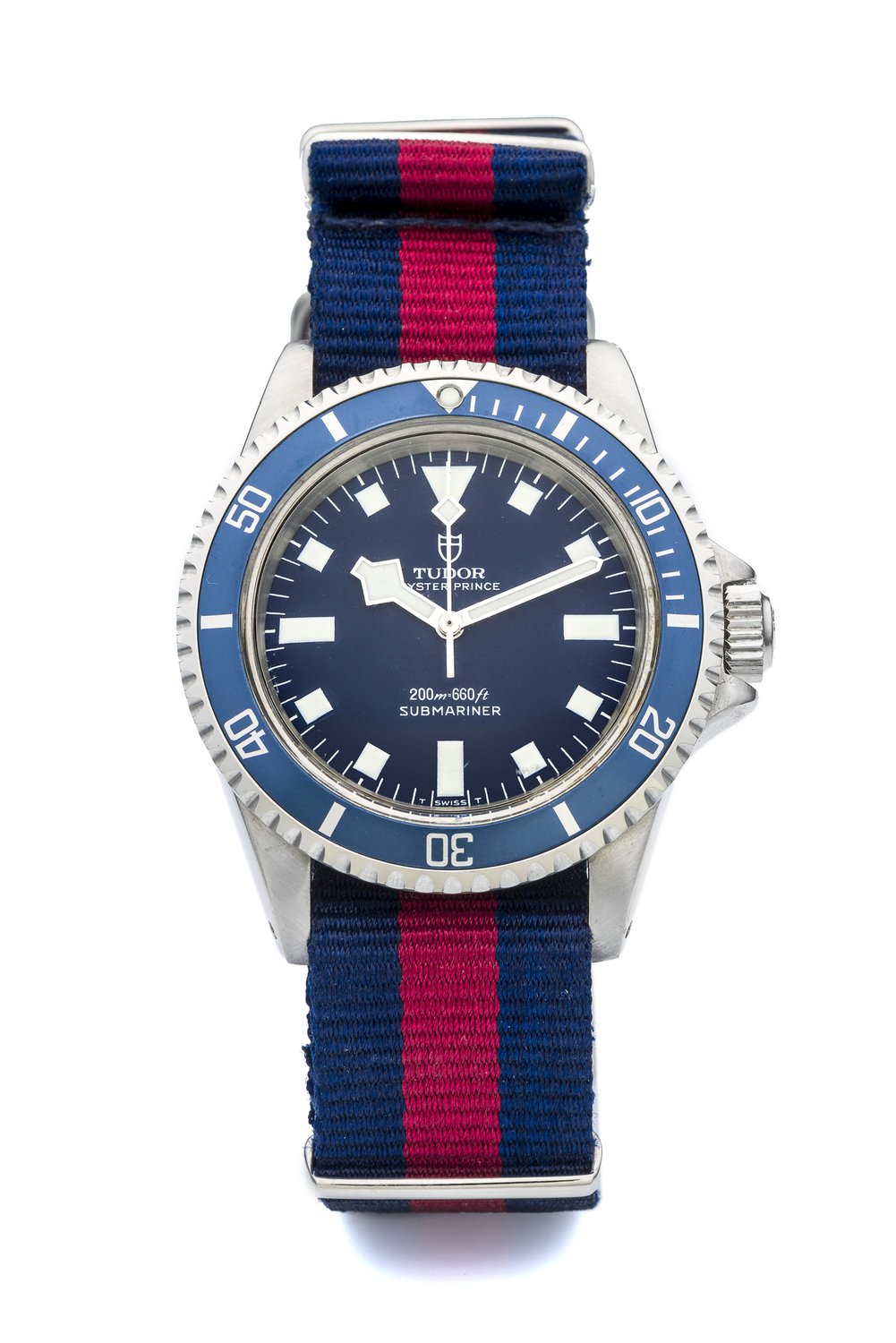
The Tudor Submariner Snowflake with date ref: 7021
Shortly after the release of the 7016 model came the vintage Tudor Submariner ref: 7021 with the added feature of a date window at 3 o’clock. This innovative date feature sported a cyclops date as seen in the Rolex Date watches released around the same time. In these Submariner watches, Tudor chose a flat crystal front to replace the domed glass front, giving the watch a more confident and larger impression on the wrist. Almost identical to the ref: 7016, the watch featured the famous Snowflake hands and a 40mm case size water-resistant to 200 meters. As the production of the Tudor ref: 7021 watches continued, more dial colour options and variations with the Mercedes hands became available. Those with the Snowflake-style hands, however, despite the condition of their dials, remain some of the most collectable vintage Tudor watches on the pre-owned luxury watch market today.
At a glance:
Name; Tudor Submariner Snowflake with date ref: 7021
Reference; 7021
Case: 40mm stainless steel
Crown: 6mm
Glass: Plexiglass
Release year: 1959
Dial: Black with luminous Snowflake hands and square hour indexes/date at 3 o’clock
Water resistance: 200 meters
Strap: Three-link stainless steel Oyster
Movement: ETA 2484 self-winding
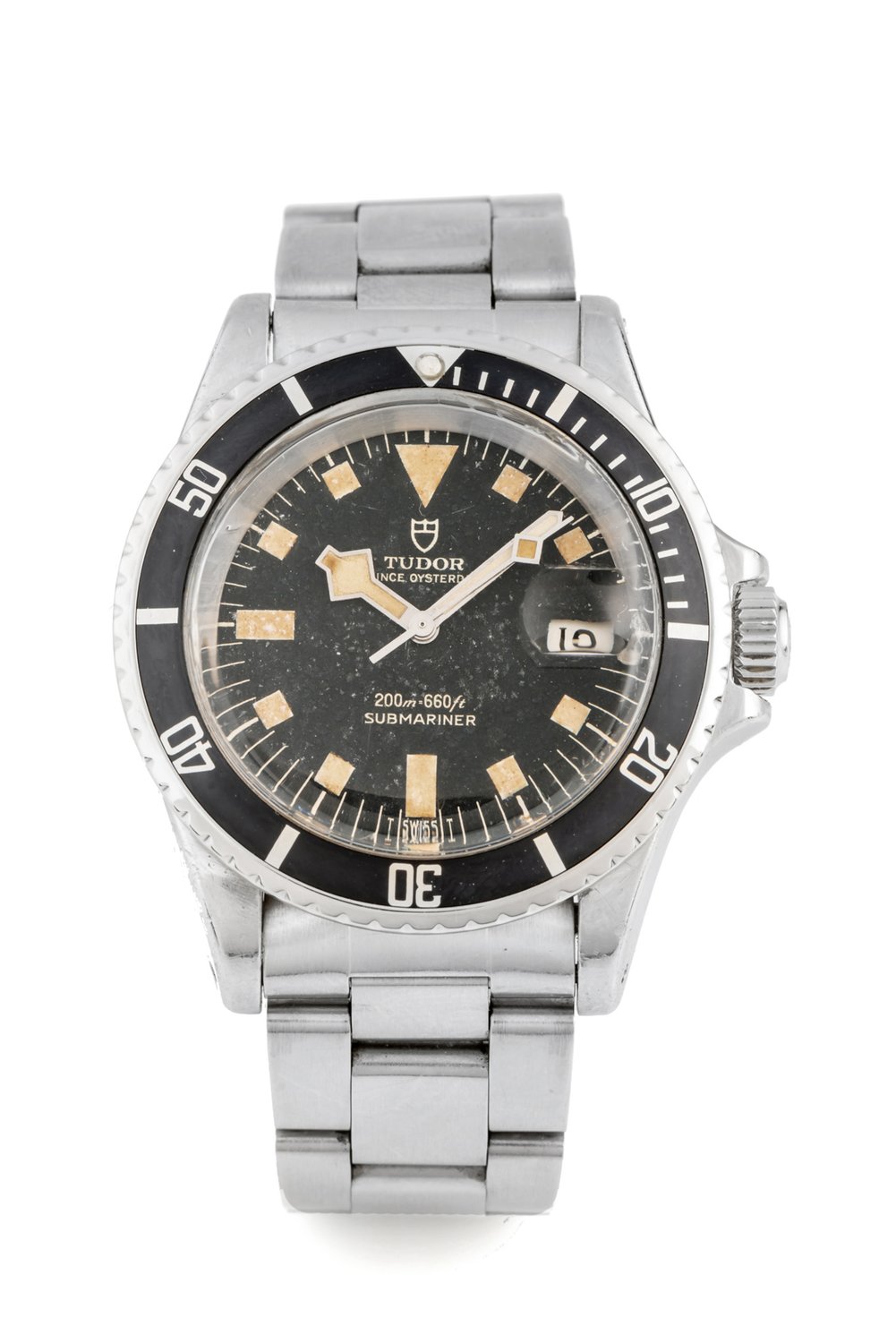
Tudor Submariner Snowflake 2 ref: 9401 and 9411
In the mid-1970s, the Tudor Submariner ref: 7016 and 7021 models were replaced with the ref: 9401 and 9411 for non-date and date iterations respectively. The main difference here is the replacement of the ETA 2483 in the ref: 7016 to the ETA 2776 in the ref: 9401 for both no-date variations, and in the date variations – the replacement of the ETA 2484 in the ref: 7021 to the newer ETA 2784 in the ref: 9411. These self-winding engines with improved power reserves offered a more robust power source that was better suited to face the conditions experienced underwater and on the wrists of sports-goers and explorers. With dial iterations offered with Mercedes and Snowflake hands and hour tracks represented by squares and circular variations - the Tudor Submariner ref: 9411 date option was produced in both blue and black dial options, as was the non-date ref: 9401. The blue dial iteration of the non-date ref: 9401 is also called Marine Nationale because of its connection to the French Navy and, as such, remains one of the most sought-after models from the entire Submariner series. Different flavours of these two “date” and “non-date” Tudor Submariner watches ran from 1975 to around 1983. The sample in the photo is taken from Kimondo and Co. collection, a high quality leather watch straps for Tudor producer based in Hong Kong.
At a glance:
Reference; 9401 and 9411 (date)
Case: 40mm stainless steel
Crown: 6mm
Glass: Plexiglass
Release year: 1975
Dial: Black/blue with luminous Snowflake/Mercedes hands and square/circle hour indexes/date at 3 o’clock (ref: 9411)
Water resistance: 200 meters
Strap: Three-link stainless steel Oyster
Movement: ETA 2776 self-winding / ETA 2784 date
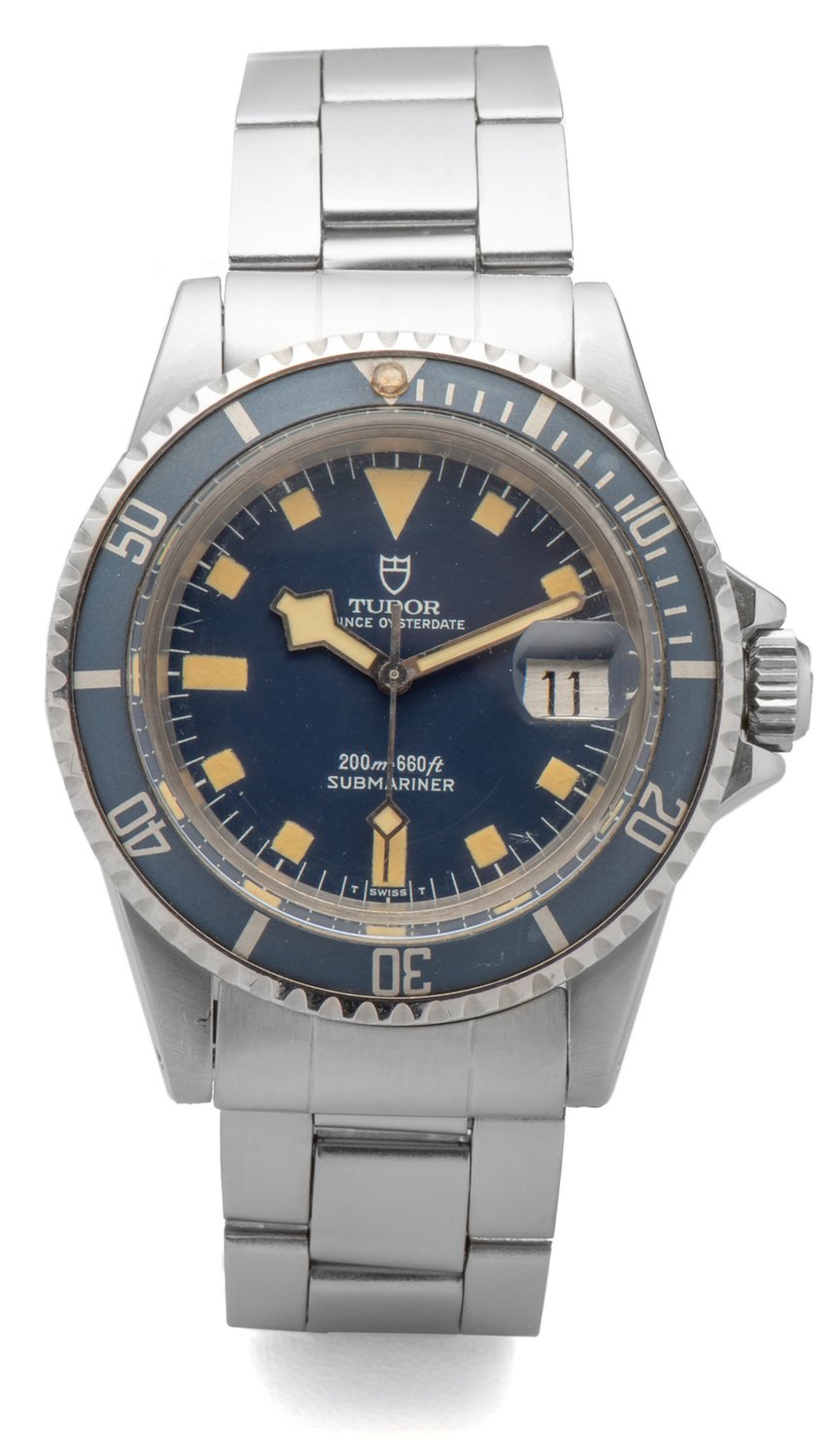
The last Tudor Submariner ref:76100
The Tudor Submariner ref: 76100 was considered the stepping stone between the 9400 series and the 7900 series which followed in the late 1980s. The 76100 model was a low-production transitional watch that was almost identical to the soon-to-be 79090 and 79190 models, but boasted an unusual lollipop hour hand. Its large surface area could accommodate more tritium for legibility in the dark. This feature, however, was more prone to cracking and breaking and so only served a short time in the Submariner series. Produced during the same time as the 94110 from the 9411 series, these two designs were almost identical. The fact that the Tudor Submariner ref: 76100 was produced in such a small supply made this model with the lollipop hands (along with a few models with Mercedes hands) highly collectable and intriguing additions to a collection.
At a glance:
Reference; 76100
Case: 40mm stainless steel
Crown: 6mm
Glass: Plexiglass
Release year: 1984
Dial: Black/blue with tritium lollipop / Mercedes hands and circle hour indexes/date at 3 o’clock
Water resistance: 200 meters
Strap: Three-link stainless steel Oyster
Movement: ETA 2784 self-winding
Tudor Submariner ref: 79090 and 79190
Signifying the third and last generation of the Tudor Submariner before it ceased production, the ref: 79090 enjoyed a production run from 1989 to the late 1990s. Even its name harkened back to the title of the original 7900 series. Following in the footsteps of the 9400 and 76000 series, the ref: 79090 was offered in a blue or black dial. Its bezel, used for the effortless measuring of elapsed time underwater, matched the colour of its respective dial, which now also featured different hour markers at 3 and 9 o’clock. These were triangular instead of rectangular now and featured exclusively in the 79190 (and the forthcoming 79090) model/s only. The case of the Tudor Submariner ref: 79090 watch was reduced slightly to 39mm, whilst inside its 200-meter water-resistant case crafted from robust stainless steel was the ETA 2824-2. This self-winding movement is still widely available throughout the industry today. The Oyster stainless steel bracelet now secured with a comfortable folding clasp and Fliplock extension links developed by Rolex. These links enable the band to be extended to an additional 26mm whilst providing a secure and comfortable fit over the top of a diving suit.
In 1995 Tudor released the Submariner ref: 79190. One of the most notable upgrades to the design of the watch was the addition of its sapphire crystal glass front. It also featured rounded hour markers, a cyclops date lens and, once again, was equipped with a unidirectional rotating bezel that would only move in a counter-clockwise direction. This eradicated the risk of the bezel accidentally extending the diver’s remaining time underwater. The bezel with deeper notches would be modified again in 1997, where steel inserts were implemented as opposed to the printed bezels of the past. The integration of the sapphire crystal glass lens promised stronger material that was more resistant to scratching. The Submariner ref: 79190 was the last chapter of the Tudor Submariner legacy. In 1999 the popular dive watch was retired, never to be revisited again.
At a glance:
Reference; 79090 and 79190
Case: 39mm stainless steel
Crown: 6mm
Glass: Sapphire crystal
Release year: 1989 /1995
Dial: Black/blue with Mercedes hands circle hour indexes/date at 3 o’clock
Water resistance: 200 meters
Strap: Three-link stainless steel Oyster
Movement: ETA 2824-2
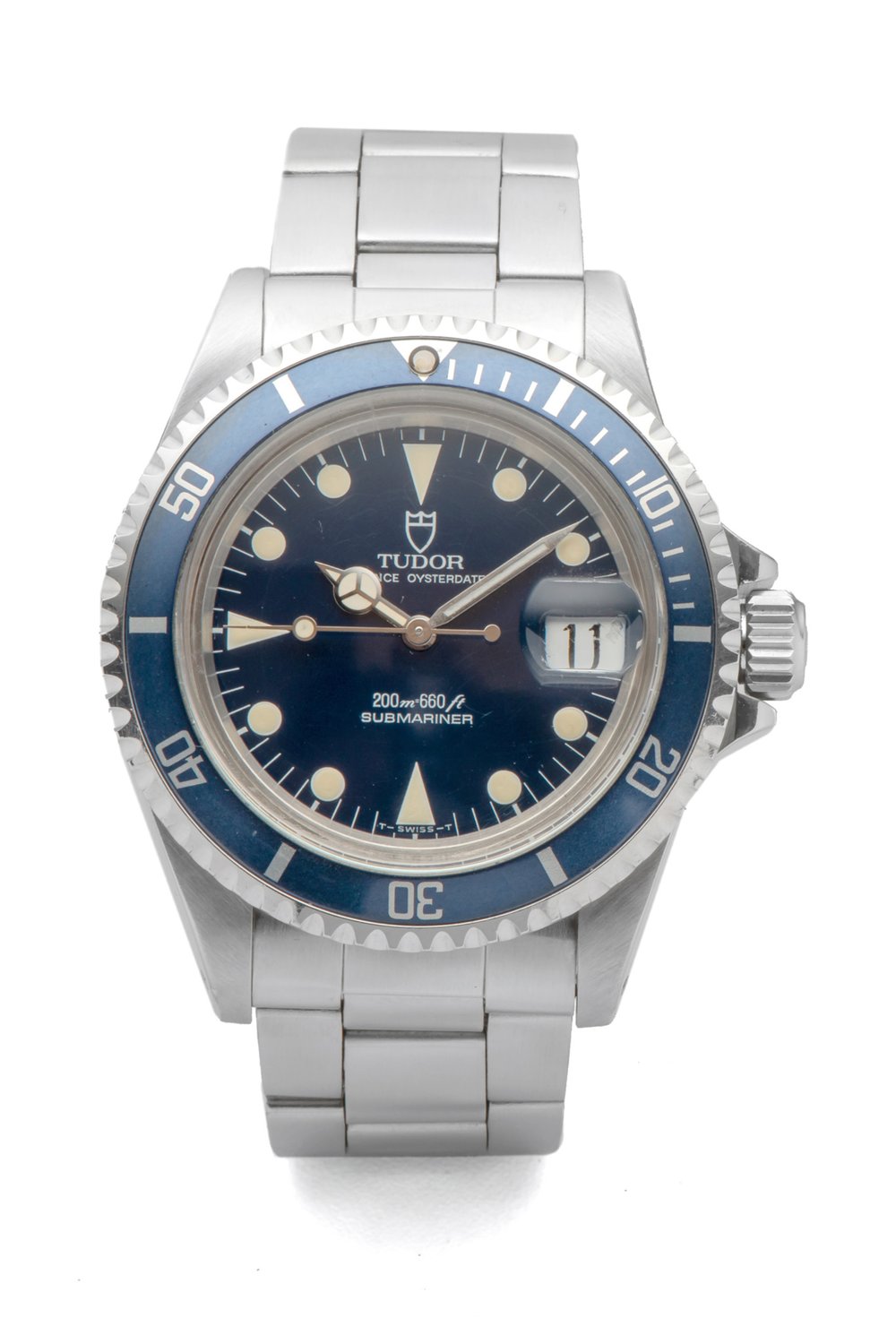
Prices of popular vintage Tudor Submariner watches
In addition to the popular vintage Submariner watches we have covered in this article, there have been many other iterations of the iconic luxury dive watch, such as the lady Submariner produced exclusively for female wrists and the Mini Submariner dedicated to the Asian market. The references covered in this article are the backbone of the Submariner collection, however. Each price, ranging from affordable to expensive reflects the desirability of each design from its respective generation. Submariner watches from the second generation, such as the 76100 are considered the most modestly priced options on the pre-owned luxury watch market while watches from the third generation used to be the most affordably priced before doubling in price over the last 5 years. Plan to spend between 4 and 6,000 EUR on models like the ref: 76100. Some of the most expensive and sought-after Tudor Submariner watches are those produced for the Marine Nationale, bearing the reference: 9401 M.N. These have become the most collectable dive watches from the series, and are priced around EUR 20,000. Watches in the mid-priced bracket can be purchased for around EUR 7000, such as the Submariner ref: 9411.
It is still unknown as to why Tudor ceased production of its Submariner dive watch collection. The decision to do so could be related to the fact that the company came out of the American market in 1996. This subsequently marked a change for Rolex as its sibling brand, which became even further detached from Tudor, focussing evermore on its exclusivity status. For a while, Tudor hit a lull and produced some of its less-popular models. It took until around 2010 for Tudor to re-emerge with a successful hit after the Submariner with the Heritage Chronograph. The vintage Submariner, however, will always remain a vastly-desired collectable thanks to its design heavily reliant on a strong retro theme and solid, faultless dive watch features